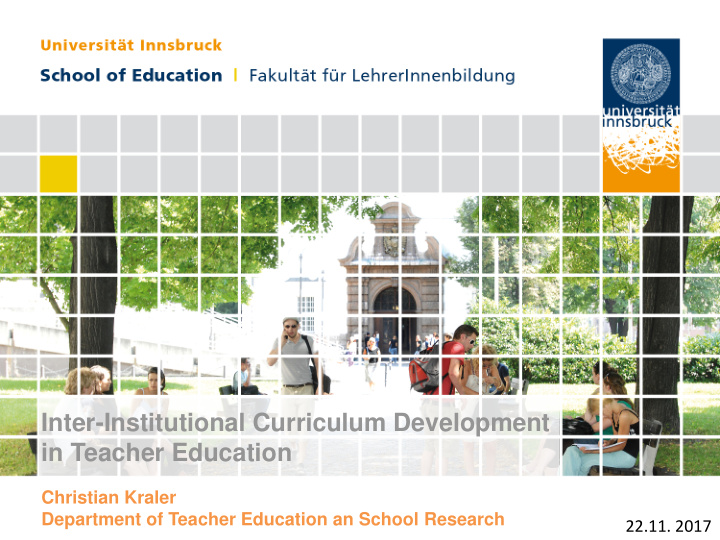



Inter-Institutional Curriculum Development in Teacher Education Christian Kraler Department of Teacher Education an School Research 22.11. 2017
Challenges… (lack of) time (but …) University vs. Specialised TE institution interinstitutional - different institutions (historically) - academic qualifications - traditions - professional concepts of TE - structures - organisation of studies - different types of schools (academic secondary school/lower level, new secondary school) - number of students Diploma (3/5+1 years) BA/MA (6+1years) Schulpädagogik/Humanwissenschaften Bildungswissenschaften (conceptual change) …
Question … structure bound ≠ assumption (tradition, practices,…) - observation change of patterns - conclusion ??????????????????????????????????????????????????????????????????????????????? Why is it so difficult to make a change in teacher education? ??????????????????????????????????????????????????????????????????????????????? hard: - time - reason(s) educational system - content - findings bureaucracy- & state driven - structure
A shift from best practice to next practice Develop opme ment o t of Question … next p xt prac acti tice change of pattern intervention be best p t prac actice good ood p prac actice critical instability Pro Process ss of f re rene newal al
serenity 無爲 Fault tolerance Creativity…
Question … How … ~> transformation ~> development ~> improvement - means - strategies - content ("back to the 'things themselves'“) Observations sticking points + fact based arguments - hierarchical structures + scientific arguments - power + common sense - interpretational sovereignty + expenses - angst & insecurity + quality - lack of information/time - …
Question … The problem of evidence based TE ´(Kraler 2009) degree of scientific confirmation high consensus high consensus ….. low evidence high evidence degree of consensus ….. ….. low consensus low consensus ….. low evidence high evidence opinion-driven evidency based teacher education teacher education
viscousity PH UIBK TE
Considerations … Educational system as a mirror of society High degree of self similarity Benoît B. Mandelbrot (1924-2010) 2 +c Mandelbrot-Menge: z n+1 =2 n
Considerations … self similarity structural self similarity (similar subsystems of society) scale invariance driven self similarity (dochotomies)
structural self similarity church theater school
scale invariance driven self similarity: 1) power feature Weisungsbefugnis distinction Weisungsbefugte Weisungsausführende Group of people ministry (regional) school administration Fachminister/in Weisungsbefugte – Weisungsausführende Landesschulrats- Landesschulrats- präsident/in präsident/in ………………. Weisungsbefugnis Bezirksschul- Bezirksschul- inspektor/in inspektor/in …………. Direktor/in Direktor/in ……. repeating structures on the different hierachial levels Lehrer/in Lehrer/in Lehrer/in Lehrer/in ……. …….
scale invariance driven self similarity: 2) knowledge feature konw ledge distinction has knowledge gains knowledge group of people teachers students primary school system secondary school system tertiary school system … change those viscous patterns
General considerations meta stability vision for the futur
General considerations module teams and interinstitutional joint leader team interinstitutional research groups (research based TE) communication & interfaces collaboration & mutual/joint experience co-evolutionary approach technology tridirectional live broadcast use of technology in teaching and learning opening space, creating new possibilities content wise and structural
communication interface usability
Recommend
More recommend